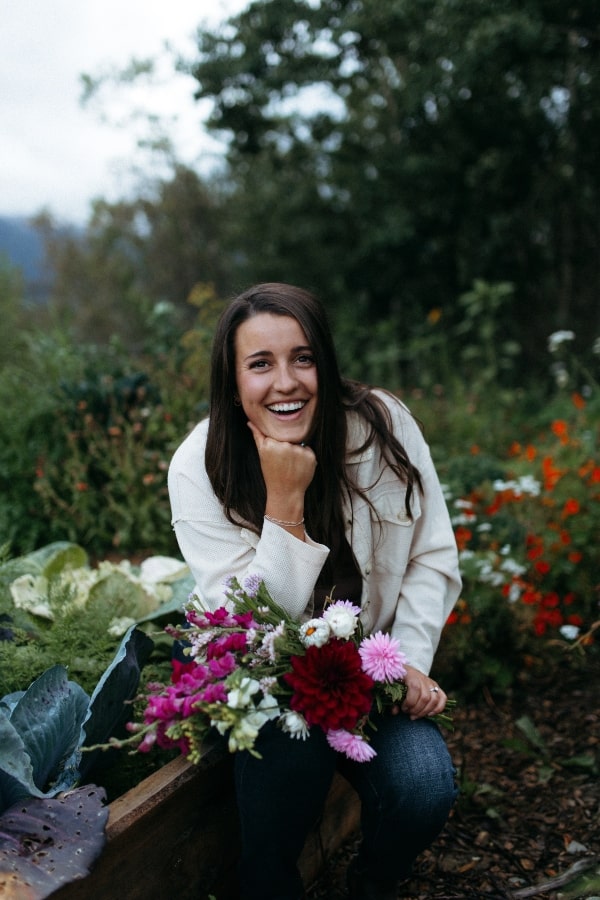Every change of the seasons always brings quite the to do list on the homestead. And preparing the yard and garden for winter is no different! Putting the garden, greenhouse, and yard to bed for the winter is a big chore.
Below are all the things that I do to get everything ready for the winter. I’m in Alaska, Zone 4. All these activities are happening between the 3rd week of September and the 2nd week of October.
Preparing the Garden
1. Empty & mulch garden beds
I empty my beds incrementally and in order of what is dying. I remove things incrementally so that I can feed it to my chickens over the course of a couple weeks.

I remove things in order of what is dying. For example, green beans are way more frost tender than kale. So I will get rid of the green beans first and continue harvesting things that are not as susceptible to frost (kale, brussel sprouts, sage, broccoli, etc)
When removing plants from the garden, I cut the stalk flush with the soil level. I leave the roots in the bed which adds organic matter to the bed.
Keep in mind, if you want to collect seeds from any of your vegetables, make sure you allow them to go to seed and don’t remove them before you collect the seeds. More on that later.
After everything is removed, I mulch all my beds with 6” of leaves. My garden gets southern exposure and is the first thing to thaw in the spring. This is wonderful for warming the soil, but it also means that the weeds get a head start. Mulching helps warm the soil and reduce weeds until I can get to my garden.
2. Plant garlic
I have an article here that has all the details of ordering garlic and planting it. I plant in the first 2 weeks of October. I amend my bed, plant the garlic, and mulch with 6” of leaves. Check out the linked blog post to read all the specifics!

3. Dig up dahlia tubers
If you grow dahlias in a climate that frosts, it’s a great practice to dig up your tubers so you can replant them the following spring. I’m still relatively new to this process, so I’m not going to share a detailed process yet. There are many methods and schools of thought!

I cut mine back around the first frost, leaving a 6” stem. Then I let them develop in the ground for a week. The frost stimulates them to make the transition from growing to developing eyes for the next growing season. After a week or so I dig them up and spray them off with a hose. Once they are dry, I will cut the tubers apart. I discard any that don’t have an eye and store them layered in a tote in peat moss.
Tubers need to be stored between 40 and 50 degrees and 80% humidity. I will check on them a few times over the winter to make sure they are doing okay. If they are dry, I’ll spray some water into the peat moss, remove any that have rotted, etc.
When I am more confident in my process I will write a blog post with more specific details!
4. Collect Seeds
Harvesting seeds is a great way to make your garden more sustainable. You can do this for vegetables and flowers. Flowers are the easiest because often by the time I go to collect them in early October, they are already dry and I can take the seeds.
If your flowers aren’t dry, you can always harvest a bunch of them, tie the stems together and hang them upside down inside to dry.


In order to collect seeds from vegetables, you need to allow them to ‘go to seed’ which means allowing them to flower. The seeds are generally in the flowers.
Preparing the Greenhouse for Winter
5. Remove plants
The same rules apply here that we talked about for preparing the garden for winter. If there is anything you wish to save seeds from, make sure you allow it to flower.
To remove plants from the beds, I cut the stalks even with the soil level. I much prefer to clean out my greenhouse in the fall versus the spring.

Typically I have way more work in the spring, so I don’t want to create even more work for myself. Additionally, it’s harder to remove things in the spring because it’s so dry and brittle. Brittle leaves wouldn’t be bad to add to your soil, however, I like to avoid adding unnecessary seeds from flowers to the soil that I’d have to be weeding later.
6. Store anything that can’t freeze
I have a number of things that need to be drained and stored before they freeze. I have a pond pump that fills a cistern and another pump that gets water from the cistern to the greenhouse. So I drain the cistern and the pumps and bring the pumps in for the winter.
I also make sure to empty my rain gauge, watering cans, thermometers, etc.
Picking up the Yard for Winter
7. Store flower pots
There are multiple areas where I have a number of flower and herb pots. I cut the plants even with the soil and I store my pots in my greenhouse. I don’t do anything with the soil at this time. In the spring, I will empty all the pots, amend the soil, and refill the pots when I plant!

8. Remaining Leaves
If there are any remaining leaves in the yard that I haven’t used to mulch my garden beds, I will collect the rest for my compost pile. Leaves are an excellent source of brown material and they break down faster than things like cardboard so you can never add enough to your compost pile!
I hope this list helps you get your garden and yard prepared for winter! Let me know in the comments if there is anything you would add to the list! Be sure to check back in the spring for when I prepare the garden for planting!



0 Comments